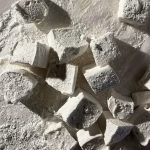Homemade Marshmallows
Servings: 28 large marshmallows
Cost: $5
Just a combination of sugars, salt, gelatin, and vanilla - these marshmallows are simply delicious
Print Recipe
Ingredients
- 14.5 oz white sugar 2 cups + 1 tbsp
- ¼ cup corn syrup or 1/3 if agave syrup
- ½ cup water for sugar syrup
- ½ cup water for the gelatin blooming
- 7 tsp gelatin about 3 packets of Knox or store-brand gelatin
- Pinch of salt
- 1 tsp pure vanilla extract
- 2 egg whites if using (for lighter/softer marshmallows)
Dusting powder
- 1 cup confectioner’s sugar sifted
- ½ cup cornstarch or corn flour
Instructions
Make the marshmallow base
- Place ½ cup of water in the mixer bowl. Add the gelatin to the water and mix to moisten the gelatin. Set aside to allow the gelatin to bloom while the sugar syrup is cooking (at least 10 minutes). Place the bowl in your mixer, with the whisk attachment.
- Place the sugar, corn syrup (or agave), and water in a pot over medium-high heat. Stir just until the sugar is moistened and mixed with the water.
- If you’re not using corn or agave syrup, place the sugar in the saucepan and pour the water along the edge of the saucepan. Gently swirl the pan to evenly distribute the heat, but do not stir. Cook until the mixture begins to bubble/boil.
- Cover the saucepan with a lid and lower the heat to medium. Let the syrup cook for 2 minutes. Do not lift the lid at this point.
- After 2 minutes, remove the lid and check to make sure there are no sugar crystals on the side of the pot or saucepan. If there are crystals, then cover the saucepan for a further minute to allow the condensation to wash down the sugar crystals into the syrup.
- Uncover and clip the sugar thermometer to the side of the saucepan. Let the sugar syrup cook until it reaches 142-145º F. If you don’t have a sugar thermometer, please check the notes for instructions on how to check if the syrup is ready with out one.
- When the sugar syrup reaches the right stage, remove it from the heat until the bubbles are gone. While the mixer is running on medium – low speed, pour the sugar syrup into the gelatin, along the wall of the bowl. Add the salt and increase the speed to medium – high.
- Whisk on medium – high for 5-7 minutes until the marshmallow base is basically 3 times the size. At this point, add vanilla extract and continue whisking for 2-3 minutes.
- Optional – whisk the 2 egg whites in a clean metal bowl until you have stiff peaks. Combine these to the whipped marshmallows for a lighter, softer finished product.
Make the dusting powder
- Mix the confectioner's sugar and cornstarch together until well combined. Set aside until needed. This will be more than enough for multiple batches, so keep the remainder in a ziploc bag or container with a lid until you need it again.
Prepare the pan
- While the marshmallow base is whisking, prepare the pan and utensils you will be using. Line a 9x9 pan with parchment paper greased with coconut oil, shortening or butter. Brush all the utensils – spoon, spatulas with the same fat as well.
Let the marshmallows set
- Scrape the marshmallow base into the prepared pan using an oiled cake spatula or flexible scraper. Spread the marshmallow evenly in the pan using the oiled spatula.
- Sieve confectioner’s sugar over the top of the marshmallow and allow the marshmallow to set for at least 6 hours.
- Turn the set marshmallow out onto a work surface dusted with dusting powder. Cut the marshmallows with an oiled knife or a pair of scissors. Toss the marshmallow in the dusting powder and store in an air-tight container.
Notes
- Increase the sugar to cups, if you’re not using agave or corn syrup
- Increase water to cup if you’re not using agave or corn syrup
- To check your sugar syrup has reached the correct stage without using a sugar thermometer, place a bowl of very cold water next to where you're cooking the syrup.
- Using a clean spoon, carefully take a little of the syrup and drop it into the bowl of cold water. Leave to cool for a moment then pick up the ball of syrup. If it’s pliable, sticky and can be moulded in your fingers easily, it has reached the soft ball stage.
- To reach the hard ball stage, continue cooking the syrup and then pour a spoonful into the bowl once more to test. It should hold together in a firm ball and will be tougher to re-shape as it cools. <<<< THIS IS WHAT YOU WANT
- As the temperature of the sugar increases, the sugar syrup will begin to go browner in the pan. It will harden immediately as it hits the water. The sugar will begin to crack and break apart under pressure. The hard crack stage is used for lollipops, spun sugar and hard toffees.
